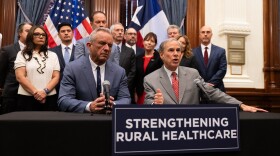A July report from the Center for Healthcare Quality and Payment Reform finds 37 of Oklahoma’s 78 rural hospitals are at risk of closing.
The report shows that’s because of “serious financial problems,” including losses of inpatient services and low monetary savings. It estimates many of the at-risk hospitals can only financially support themselves for the next six to seven years.
Twenty-four of those rural hospitals, however, are at immediate risk of closure — which means they are at risk of closing in the next two to three years.
But Rich Rasmussen, president and CEO of the Oklahoma Hospital Association, said Oklahoma voters’ 2020 decision to expand Medicaid will help rural hospitals across the state avoid closure.
“By approving Medicaid expansion in the state, it especially allows those rural providers to be able to have payment coverage for those who are uninsured and meet that income threshold for Medicaid expansion,” Rasmussen said.
However, the report cautions the primary reason rural hospitals are at risk of closing because of insufficient payments from private health insurers, especially for primary care and emergency services. It notes that about half of the services provided at the average rural hospital are delivered to patients with private insurance plans.
Rasmussen said hospitals are often the largest employer in rural communities, therefore a hospital closure would have a drastic impact on its small-town economies as well as increase disparities for residents seeking care.
“If caregivers leave because there’s no longer a hospital employment opportunity, you lose the benefit of them being homeowners, renters or purchasers in the community,” he said. “It would also result in patients having to travel further for their care or in the event of an emergency.”
At least 31 rural hospitals have closed nationwide since the start of 2020, according to the report. Clinton Regional Hospital is the most recent rural hospital to close in Oklahoma. It closed on Dec. 31, 2022, but the city noted earlier this year that it’s working to get the hospital reopened.
To help prevent rural hospitals from closing, the Center for Healthcare Quality and Payment Reform advocates for private health insurers to increase payments to cover the cost of primary and emergency care in rural communities.
The report also adds that rural hospitals should not have to make the difficult decision to give up inpatient care services to receive higher payment for other services, as required under the federal “Rural Emergency Hospital” program. It said doing so would make it harder for rural residents to receive quality care.
Get the latest Oklahoma news in your inbox every weekday morning. * indicates required
Copyright 2023 KOSU. To see more, visit KOSU. 9(MDA4OTAxNzAzMDEzMjc0MTc2MzA5ZDZlMw004))







